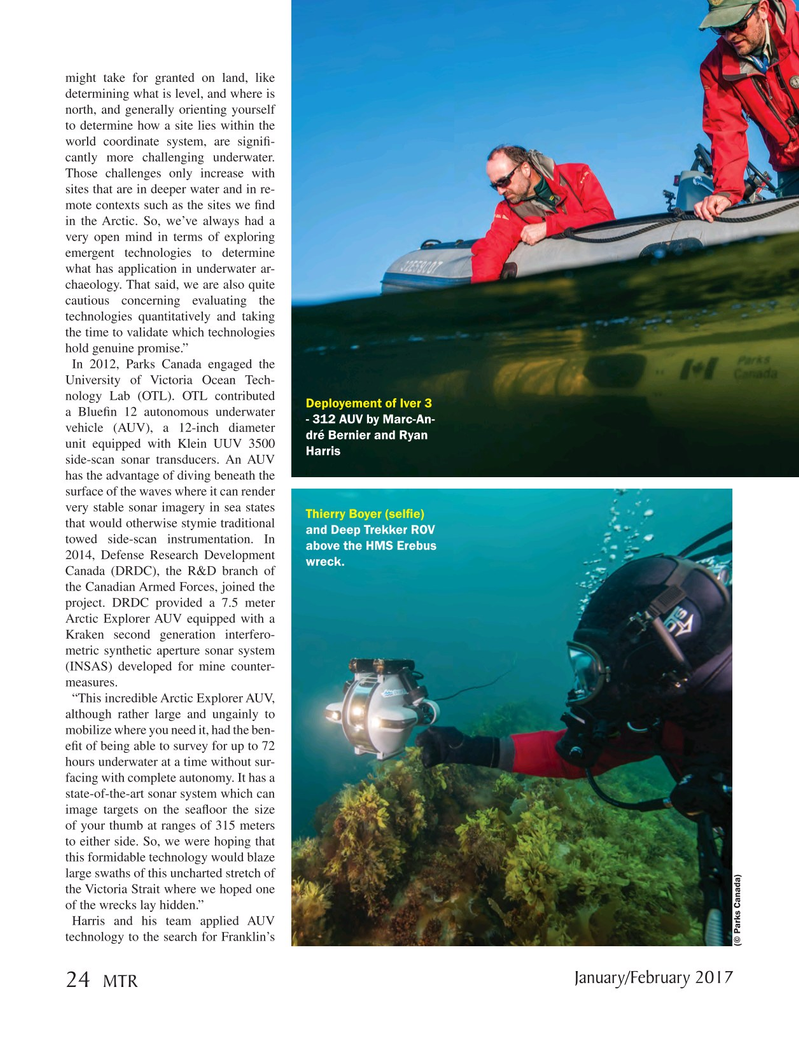
Page 24: of Marine Technology Magazine (January 2017)
Underwater Vehicle Annual: ROV, AUV, and UUVs
Read this page in Pdf, Flash or Html5 edition of January 2017 Marine Technology Magazine
might take for granted on land, like determining what is level, and where is north, and generally orienting yourself to determine how a site lies within the world coordinate system, are signi? - cantly more challenging underwater.
Those challenges only increase with sites that are in deeper water and in re- mote contexts such as the sites we ? nd in the Arctic. So, we’ve always had a very open mind in terms of exploring emergent technologies to determine what has application in underwater ar- chaeology. That said, we are also quite cautious concerning evaluating the technologies quantitatively and taking the time to validate which technologies hold genuine promise.”
In 2012, Parks Canada engaged the
University of Victoria Ocean Tech- nology Lab (OTL). OTL contributed
Deployement of Iver 3 a Blue? n 12 autonomous underwater - 312 AUV by Marc-An- vehicle (AUV), a 12-inch diameter dré Bernier and Ryan unit equipped with Klein UUV 3500
Harris side-scan sonar transducers. An AUV has the advantage of diving beneath the surface of the waves where it can render very stable sonar imagery in sea states
Thierry Boyer (sel? e) that would otherwise stymie traditional and Deep Trekker ROV towed side-scan instrumentation. In above the HMS Erebus 2014, Defense Research Development wreck.
Canada (DRDC), the R&D branch of the Canadian Armed Forces, joined the project. DRDC provided a 7.5 meter
Arctic Explorer AUV equipped with a
Kraken second generation interfero- metric synthetic aperture sonar system (INSAS) developed for mine counter- measures. “This incredible Arctic Explorer AUV, although rather large and ungainly to mobilize where you need it, had the ben- e? t of being able to survey for up to 72 hours underwater at a time without sur- facing with complete autonomy. It has a state-of-the-art sonar system which can image targets on the sea? oor the size of your thumb at ranges of 315 meters to either side. So, we were hoping that this formidable technology would blaze large swaths of this uncharted stretch of the Victoria Strait where we hoped one of the wrecks lay hidden.”
Harris and his team applied AUV technology to the search for Franklin’s (© Parks Canada)
January/February 2017 24 MTR
MTR #1 (18-33).indd 24 MTR #1 (18-33).indd 24 1/24/2017 10:26:06 AM1/24/2017 10:26:06 AM

 23
23

 25
25
